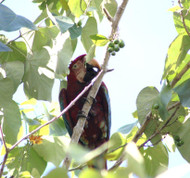Parrot Watching in Mato Grosso Part 1
Posted by Mato grosso, Parrot conservation on 26/1/2024
The true, geodesic centre of South America was pinpointed by satellite. In the centre of Brazil, in the state of Mato Grosso, it is near the small town of Chapada dos Guimaraes. There is a 300 sq km national park of the same name. During my November 2011 visit to the state of Mato Grosso this was our first location. I was with Steve Brookes who organises Parrot-watching trips (www.wildParrotsupclose.com), two other members of our small party and our local bird guide, Ricardo.
A good paved road leads to the national park. It passes through spectacular red-brown cliffs, eroded in places into contorted pinnacles. We were told that Green-winged Macaws nested in a huge indentation in one rock face. We reached the entrance to the national park at 7.30am. Opening time was 9am but Ricardo was on very good terms with the rangers!

Traversing a sloping path we soon found ourselves on the summit of a table-top mountain. At 800m this is the highest point in Mato Grosso. The view was spectacular! To our left a huge waterfall fell into the canyon below us. Forest stretched away on either side. Soon after we arrived four Illiger’s Macaws flew by. This is the least common of the small Macaws and seldom easy to observe. We did not see this species at any other location.
Pionus
It was a joy to look down into the canyon. Trees grew at strange angles out of the rock face. Three Blue-headed Pionus often used these small trees to perch and observe. White-eyed Conures were numerous and active, flying around in small groups, showing off their yellow under wing coverts, throughout the one and a half hours we were there.
A Toco Toucan perched motionless, all that time, perhaps hoping to feast on Conure eggs or chicks should a nest be left unoccupied. We only surmised that the Conures were nesting here. It was certainly a perfect, inaccessible location, a sublime setting where one felt totally in tune with nature. The only sounds were the waterfall and the wind, and the occasional cries of the Conures.
Suddenly a pair of Green-winged Macaws flew silently into a large tree on the cliff face, not too far away. Then they departed down the canyon.
Macaws in flight are always impressive but when you can look down on them, they engender a feeling of awe.
The pair flew close to the waterfall, their blue wings and skyblue rump and upper tail coverts shining in the sun.
Conures
In this area we saw also Noble Macaws and the more numerous and easy to observe Golden-crowned Conures - I find it hard to use the modern name, Peach-fronted, even although it is the front, not the crown that has the contrasting colour.

We saw them in small groups, in all the locations we visited, except the Amazon. I have always admired this species and have memories of a wonderful breeding pair at Loro Parque.
At 9.15am the idyllic atmosphere ended when tourists began to arrive to photograph each other against the backdrop of the waterfall. They did not seem to notice the bird life. That was our signal to depart.
That afternoon I achieved a long-held dream of seeing the Yellow-faced Parrot -- formerly Amazona xanthops, now correctly moved out of the genus and named Alipiopsitta xanthops -- in the wild. But that is another story!
Next day we drove back to Cuiabá (the city we had flown into after landing in Sao Paulo) and took the Transpantaneira road which bisects the Pantanal.
The state of Mato Grosso remained largely unexplored until the early 1960s when the Brazilian government decided that a road would be built through this virgin area. As it is flooded for about half the year, this was no easy task.
Road
Roughly constructed wooden bridges are encountered approximately every kilometer as the red earth road passes over one of the countless rivers.
This is the world’s largest wetland. Extremely rich in birdlife, about 700 species occur in this wonderland which extends over 150,000 sq km. Much of it is privately owned by cattle ranchers.
In recent years many tourist lodges have opened up, attracting wildlife enthusiasts from all over the world. They include André von Thuronyi, owner of Araras Eco Lodge in the northern Pantanal. It was everything one could wish for: comfortable and friendly with a multitude of Parrots.

Hyacinthine Macaws were nesting in a huge tarumeira tree a stone’s throw from my room.
Quaker Parakeets and Maximilian’s Parrots were feeding in a mango tree a few feet above my head.
Pantanal
Blue-crowned Conures, not common here, were glimpsed one morning feeding on the ground with a group of Golden-crowned Conures. And one morning, away from the lodge, we had a distant sighting of Yellow-collared Macaws.
Probably the wariest species was the Blue-fronted Amazon. Those of the Pantanal are quite distinctive, with a large yellow feathered area around the eye and a blue forehead. But it was difficult to get a close look at them.
Throughout much of Brazil, for centuries their chicks have been removed from every accessible nest and hundreds of thousands have been trapped for the pet trade. No wonder they view humans with suspicion.
To read Part 2 click here.

